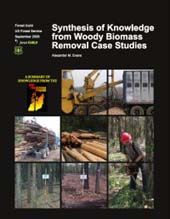Interest in woody biomass from forests has increased because of rising fossil fuel costs, concerns about greenhouse gas emissions from fossil fuels, and the threat of catastrophic wildfires. However, getting woody biomass from the forest to the consumer presents economic and logistical challenges. Woody biomass is the lowest-value material removed from the forest, usually logging slash, small-diameter trees, tops, limbs, or trees that can not be sold as timber. This report brings together 45 case studies of how biomass is removed from forests and used across the country to demonstrate the wide variety of successful strategies, funding sources, harvesting operations, utilization outlets, and silvicultural prescriptions. The case studies reveal regional differences and the importance of designing projects to fit the biophysical conditions and social context of each site. Taken together, these case studies show that all aspects of woody biomass removals, from markets to mechanization, are evolving. This report identifies the building blocks for successful biomass projects—including public involvement, partnerships with contractors, and judicious mechanization of harvest operations—that are present in the management of many forests across the country.
Image Source: crmw.org

